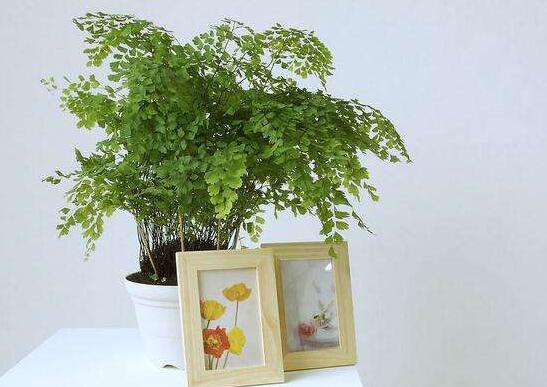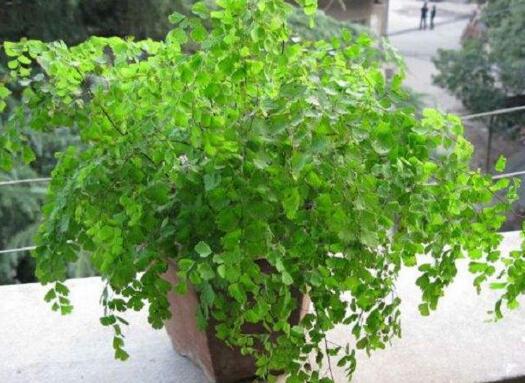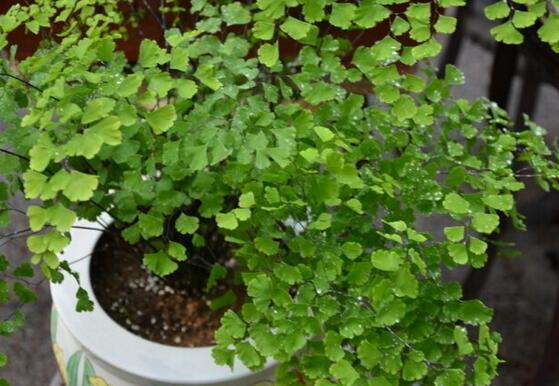How to water Dryopteris Dryopteris, watering method / watering time / water quality selection
Although the plant of Dryopteris is small, its growth rate is very fast, and there is a greater demand for water during the growing period, because it likes a humid environment, so we must pay attention to reasonable watering in daily management. so how to water Dryopteris? Below, we will introduce the watering method of Dryopteris in detail from the aspects of watering time, matters needing attention and so on.
How to water Dryopteris
What kind of water is poured on Dryopteris?

It does not have high requirements for water quality, as long as the alkalinity of the water is not too high, it can be irrigated to Dryopteris, but it should be noted that the water should be clean and healthy, and the most suitable water is Rain Water, followed by clear river or lake water, followed by well water or tap water, of course, it can also be irrigated with rice water.
Second, Dryopteris fern is watered once a few days
1. Growth period
Generally, the growth period of Dryopteris Dryopteris is from March to November every year. During this period, you can water Dryopteris once a day, and you don't need much water each time. Pay attention to observe the soil moisture, if the soil is slightly moist.
2. Summer watering
Although the growth of Dryopteris is not necessarily the fastest in summer, but because of the high temperature, the evaporation of water is the fastest. How to water it at this time? Need to water more times than usual, can be watered once in the morning and evening, but if the soil is found to be moist in the evening, you can choose not to water.
3. Watering in autumn
Watering in autumn is similar to that in spring, but it should be noted that the temperature begins to drop significantly at the end of autumn, and it is necessary to control the number of watering, as long as the soil does not dry up, the method is whether the soil surface is white or not. if it is white, it means watering is needed.
4. Watering in winter
Watering in winter must be cautious, because the temperature at this time is relatively low, and clematis often only need a dormant period in winter, so watering is based on the principle of avoiding soil dryness. When the soil is found to be relatively dry, water can be watered at the edge of the flowerpot at noon, and the water temperature should not be too low.
Points for attention in watering Dryopteris
1. Do not accumulate water
As each flower friend has a different pace of life, and sometimes cannot be watered often because of busy work and too many chores, some flower friends choose to water a lot of water at one time, resulting in deep water in the flowerpot of Dryopteris. When looking back, I found that the leaves withered and yellowed, which was caused by stagnant water leading to root rot, so water must not be accumulated.
2. Avoid water shortage
When raising Dryopteris, what it fears most is the long-term lack of water, which will lead to the inability of new leaves to germinate and the early shedding of old leaves, which not only affects the ornamental quality, but also threatens the health of Dryopteris, so it is usually necessary to develop the habit of timely watering. If you go out for a long time, you need to water thoroughly and ensure a ventilated environment.
What to do about the yellowing of fern leaves? five techniques to improve yellowing / including coping methods
Dryopteris is a common indoor foliage plant, because it is simple and adaptable to cultivation, but in conservation and management, some flower friends encounter the phenomenon of yellowing leaves, which not only cannot be seen as an ornamental fern, but may also cause the whole plant to wither and even die, which is very distressing to flower friends. What about the yellowing leaves of Dryopteris? The editor summarizes five reasons and countermeasures according to the experience of Hua you.
What if the leaves of Dryopteris fern turn yellow?
From the breeding experience of flower friends, the main reasons for the yellowing of Dryopteris leaves are: overwatering, lack of light, soil discomfort, excessive fertilization, diseases and insect pests. We will understand in detail from these five aspects.
1. Overwatering
In the culture method of Dryopteris, we know that it is more resistant to humid environment, but overwatering will cause the root of Dryopteris to be unable to contact the outside air, which restricts its respiration, thus affecting the growth and development of the root. causes the young leaves to turn yellowish, and then the old leaves turn yellow and fall off.
Countermeasures: there must be no stagnant water when watering, the specific method can refer to the detailed introduction of how to water the fern, in addition, each watering should observe whether there is water flowing out from the drainage hole at the bottom, if the stagnant water can not be discharged in time, it shows that there are problems in soil drainage, and it is necessary to turn the soil or change the basin in time.
Second, lack of light
The most suitable light condition for Dryopteris is bright light but not strong light, so some flower friends will put it indoors to breed it. As a result, they do not pay attention to the change of light and put it in places with weak light, such as bathrooms, storage rooms, and so on. It makes its leaves yellow because of lack of light.
How to deal with it: what to do about the yellowing of fern leaves caused by lack of light? The answer is to increase light. It is best not to put Dryopteris in a very weak light environment. If there is not enough light at home, you can use light to make up the light. Make sure that Dryopteris can enjoy about 6 hours of light every day.
Third, soil discomfort
Most plants prefer neutral or slightly acidic soil, and Dryopteris is no exception. If the soil used in breeding is too alkaline, or the water quality is too alkaline when watering, the leaves of Dryopteris will fade and the leaf edges will turn yellow over time, because the soil will lack iron.
Countermeasures: acid soil should be the best, loam, rotten leaf soil, river sand can be mixed, the water quality can not be alkaline when watering, you can pour some alum fertilizer water to adjust the PH value of the soil.
IV. Excessive fertilization
The demand for fertilizer for Dryopteris is relatively low. During the peak growth period, it is OK to apply thin liquid fertilizer once a month. If too much fertilizer is applied, the tips of the old leaves will be scorched yellow, the new leaves will be thickened, and the elegant leaves will become less beautiful.
Countermeasures: if you have applied too much fertilizer, you need to increase the amount of water to let the excess fertilizer flow out of the drain hole with water, and then you should pay attention to reasonable fertilization, and the concentration of fertilizer should not be too high each time.
5. Diseases and insect pests
Although the probability of the occurrence of diseases and insect pests is not high, it does lead to one of the common reasons for the yellowing of fern leaves. Because many flower friends do not know much about diseases and insect pests, they often think that the leaves are yellowed due to improper breeding methods. So when looking for the cause, we must pay attention to observe whether there are disease spots or honeydew on the leaves.
Countermeasures: usually to strengthen maintenance and management to reduce the probability of diseases and insect pests, disinfect the soil and roots when planting, if there are diseases and insect pests need to spray drugs for control, commonly used drugs are carbendazim, malathion and so on.
Introduction to picture names and culture methods of common pteridophytes
█ fengshui plants > > choose the right fengshui plants to feel the comfort of nature
█ mosquito repellent plants > > what are the common mosquito repellent plants? are they really effective?
█ purifying plants > > 10 indoor plants that can purify the air are highly recommended.
Pteridophyte is actually a very main class of plants, which belongs to the lower phylum of high-grade plants, and is also a primitive vascular plant. Most of pteridophytes are herbaceous plants, of course, a few are woody plants, and pteridophytes are mainly propagated by one spore, so the alternation of generations is obvious, asexual generations are dominant, and there are more fern species. most of them are distributed in the area south of the Yangtze River, so let's learn about the species and culture methods of some ferns.
Boston fern, a common fern in ☼
Boston fern is a perennial evergreen fern herb, this plant belongs to drooping leaf-like foliage plants, the origin is tropical and subtropical areas, in Hainan Province, China, the distribution of such plants, we all know that most ferns are very beautiful and elegant, of course, Boston ferns will not be excluded, the leaves of this plant are bright, and the plants are light and elegant, if the breeze strikes Then the leaves wobble gently, like dancers dancing.
Culture methods:
Environment: Boston fern likes astigmatism, so it is appropriate to put it indoors with bright scattered light in spring and summer, if the sun is strong, do not put it directly in the sun, so that the leaves are easy to turn yellow, but we need to enhance our daily life in winter. otherwise, the leaf color is still easy to yellowing, and some of the leaf edges are even dry.
Water and fertilizer: Boston fern likes a humid environment and should have an adequate supply of water during the growing season. Although we have to keep the soil moist, but often watering, can not accumulate water, otherwise the leaves at the bottom will wither and fall off.
Dryopteris Dryopteris, a common fern in ☼
Dryopteris is a perennial evergreen herb. The leaves of this plant are relatively light green, and its thin leaves are matched with black and shiny petioles, which makes people feel particularly elegant. Because of its slender stems and some resemblance to wire, it is named Dryopteris.
Culture methods:
Dryopteris prefers loose, permeable and fertile soil, which can be cultivated in pots with a mixture of loam, rotten leaf soil and river sand. Liquid fertilizer is applied once a week during the growing period, and pay attention to keep the basin soil moist and high air humidity. In the dry season, water can often be sprinkled on the ground around the plant to increase air humidity.
Iron Crown, a common fern in ☼
The iron crown aquatic leaves and aquatic leaves have the same appearance, with striped rhizomes and black or dark brown adventitious roots in tropical regions from Java to Philippines and Southeast Asia. Iron crown belongs to the angiosperm phylum, alisma. This kind of aquatic plant has good adaptability, low demand for light and easy to grow.
Culture methods:
Lighting: Crown grass generally does not need strong light, but still needs enough light.
Water quality: the requirement of water quality is not high, as long as it is suitable for water plants, most of them can adapt to it.
Carbon dioxide: adding carbon dioxide is good for aquatic plants, but some varieties will grow even without adding carbon dioxide as long as the water quality is below PH7.0.
Fertilizer: the bottom bed needs to have enough base fertilizer. If the color of the new leaves in the planting is too white, it means that the fertilizer is insufficient and liquid fertilizer can be added to make it up.
Fan fern, a common fern in ☼
Fan fern is a species of fan fern of Polypodiaceae, this plant is mainly distributed in southwest China, and it is moist evergreen areas or valleys. Fan fern can be said to be a pteridophyte endemic to China, which has been listed as a secondary protected and endangered species in China.
Culture methods:
The fan fern pot should be planted in a shallow pot, and garden soil and rotten leaf soil can be mixed at 1:2. Daily watering as long as keep the basin soil moist, high temperature and dry in summer, can be properly sprayed with water to increase the growth humidity of ferns, and fertilize once every 2 months. Potted ferns need to be placed in sunny places and the winter night temperature should be controlled at 8-10 ℃ to ensure that the leaves are green through the winter.
Summary: above we simply take you to understand some of the fern name culture methods, but also enjoy their pictures, I believe you have a deeper understanding of pteridophytes, there are many species of pteridophytes, and the basic pteridophyte posture is very beautiful, has a high ornamental value.
- Prev

How to raise Dryopteris, how to cultivate Dryopteris and matters needing attention / avoid drying and strong light
Dryopteris can not only observe the leaves, but also remove formaldehyde, nicotine and other harmful substances at home, and the method of maintenance and management is relatively simple, so more and more people are going to keep several pots at home.
- Next

How to raise Dryopteris in winter, the temperature is above 10 degrees / increase light to avoid strong light / stop fertilization
Through the culture method of Dryopteris, we know that it likes a warm and humid environment, but because its cold tolerance is relatively general, how to maintain it in winter has become a concern for many flower friends, because it is related to whether the leaves of Dryopteris can be kept fresh green.
Related
- Fuxing push coffee new agricultural production and marketing class: lack of small-scale processing plants
- Jujube rice field leisure farm deep ploughing Yilan for five years to create a space for organic food and play
- Nongyu Farm-A trial of organic papaya for brave women with advanced technology
- Four points for attention in the prevention and control of diseases and insect pests of edible fungi
- How to add nutrient solution to Edible Fungi
- Is there any good way to control edible fungus mites?
- Open Inoculation Technology of Edible Fungi
- Is there any clever way to use fertilizer for edible fungus in winter?
- What agents are used to kill the pathogens of edible fungi in the mushroom shed?
- Rapid drying of Edible Fungi

